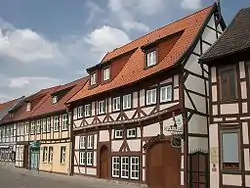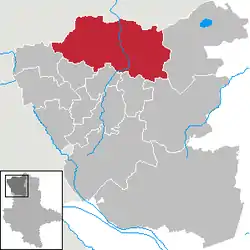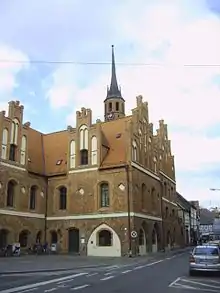Salzwedel
Salzwedel (German pronunciation: [ˈzaltsveːdəl], officially known as Hansestadt Salzwedel), is a town in Saxony-Anhalt, Germany. It is the capital of the district (Kreis) of Altmarkkreis Salzwedel, and has a population of approximately 21,500. Salzwedel is located on the German Timber-Frame Road.
Salzwedel | |
|---|---|
 Typical old housing in Salzwedel | |
 Flag  Coat of arms | |
Location of Salzwedel within Altmarkkreis Salzwedel district  | |
 Salzwedel  Salzwedel | |
| Coordinates: 52°51′N 11°09′E | |
| Country | Germany |
| State | Saxony-Anhalt |
| District | Altmarkkreis Salzwedel |
| Government | |
| • Mayor | Sabine Blümel |
| Area | |
| • Total | 304.53 km2 (117.58 sq mi) |
| Elevation | 19 m (62 ft) |
| Population (2019-12-31)[1] | |
| • Total | 23,453 |
| • Density | 77/km2 (200/sq mi) |
| Time zone | UTC+01:00 (CET) |
| • Summer (DST) | UTC+02:00 (CEST) |
| Postal codes | 29410, 29413, 29416 |
| Dialling codes | 03901, 039032, 039033, 039037, 039038 |
| Vehicle registration | SAW |
| Website | www.salzwedel.de |
Geography
Salzwedel is situated at the Jeetze River in the northwestern part of the Altmark. It is located between Hamburg and Magdeburg. Distances from Uelzen are 44 km (27 mi) E, 12 km (7 mi) S of Lüchow, 41 km (25 mi) N of Gardelegen and 24 km (15 mi) W of Arendsee. In 1968 test drillings reveal a significant reservoir of natural gas near the city.
History
The castle of Salzwedel in the Altmark was first documented in 1112. As part of the Margraviate of Brandenburg, the settlement was first mentioned as a town in 1233. To the northeast of the old town (Altstadt), a new town (Neustadt) began development in 1247. In the Middle Ages Salzwedel belonged to the Hanseatic League from 1263 to 1518. As to religion Salzwedel belonged to the Diocese of Verden (till 1648).
The city from 1247 began developing as a reestablishment from the old part of the town. In 1701 it became part of the Kingdom of Prussia. In 1713, the two towns Altstadt and Neustadt became one. Salzwedel became part of the Prussian Province of Saxony in 1815 after the Napoleonic Wars. In 1870 it received a railroad connection. The medieval part of the town remains the commercial and administrative center of the town until today.
As in other German cities during the time of Nazi Germany under Adolf Hitler, the Jewish residents of the city were systematically deprived of their rights, then expelled from the city.

In 1943, the Neuengamme concentration camp built a female subcamp in Salzwedel, capable of holding more than 1,000 female prisoners. Eventually more than 3,000 women were held there, both Jews and non-Jews. The guard staff at the camp included sixty SS men and women. One Aufseherin is known today by name, Lieselotte Darnstaedt, who was born in 1908. Darnstaedt also served at Ravensbrück before coming to Salzwedel. On April 29, 1945, the US Army liberated the Salzwedel women's subcamp, and also a men's camp nearby for male non-German political prisoners. They were shocked to find more than ninety corpses of women who had died of typhus, dysentery and malaria. At the beginning of 1945, prior to the arrival of American ground forces, Allied war planes attacked the main train station of Salzwedel, killing 300 people. The US Army eventually turned over control of the city to the Soviet Red Army, causing Salzwedel to become part of the German Democratic Republic.
On November 9, 1989 the East-West German border crossing near Salzwedel was opened, along with East-West border crossings in the rest of the country, allowing East Germans residing in Salzwedel and elsewhere to travel freely to West Germany for the first time since the building of the Berlin Wall. In 1990 Salzwedel received its first democratically elected city government.
The official name of the city was changed into Hansestadt Salzwedel on 1 April 2008, in reference to its history as a member of the Hanseatic League.
In 2010 the town incorporated the village and former municipality of Riebau.
Population development
- 1998 – 20,614
- 1999 – 20,499
- 2000 – 20,349
- 2001 – 20,130
- 2002 – 19,926
- 2003 – 21,360
- 2004 – 21,070
- 2005 – 21,316
- 2006 – 20,777
- 2015 – 24,410
Mayors
Sabine Danicke (independent) was elected as the mayor in 2008. From January 2011 she was the Lord Mayor. Since March 2016 Sabine Blümel is the Lord Mayor.
Culture and sights


Main sights

Salzwedel's sites of interest include the historic part of town, encompassed by the historic city wall and town gates. The city also contains the birth house of Jenny von Westphalen, later the wife of Karl Marx.
- numerous half-timbered houses
- town gates (Neuperver Gate, Stonegate) and medieval city fortifications
- remains of a castle (Castle Tower and Garden)
- Townhall (former monastery)
- Townhall Tower
- The Monk Church
- gothic Brickchurches St.Marien, St.Katharina und St.Lorenz
- another churches: St. Georg and Holy-Spirit-Church
- former Townhall, today's local court of Salzwedel
- Fairy-Tale Garden
- Johann-Friedrich-Danneil-Museum
- "Baumkuchen" Bakeries
Festivals
- Parkfestival, music event taking part in a 2-year-rhythm with the participation of national and international artists like Die Prinzen, Nina Hagen, Joe Cocker, Reamon, Heather Nova, Leningrad Cowboys, Madsen, Blackmail, City and so on.
- Smack-Festival, one of the biggest Hard-Rock-Festivals in Saxony-Anhalt.
Cuisine
The delicacies of the town are Baumkuchen, Salzwedeler (Altmärker) Wedding-Soup and Tiegelbraten (mutton).
Transport
Salzwedel is accessed by route 71 (north to south) and 248 (west to east). Access to the nearest autobahn is A39 which is 59 kilometres (37 miles) away in Wolfsburg, the A250 is 80.9 km (50.3 mi) away in Lüneburg, the A24 in Dreieck and the A241 is 81.4 km (50.6 mi) away. Salzwedel station is on the Stendal–Uelzen railway, part of the America Line (Amerikalinie), which was restored in the 1990s linking Berlin and Bremen. The line connects Stendal and Uelzen. Other stations are in Wittenberge near Arendsee and in Oebisfelde.
Sons and daughters of the town

- Stephan Praetorius (1536–1604), pastor
- Johann Walther (1563-1620), deacon and preacher at the Johanneskirche, Danzig
- Balthasar Christian Bertram (died 1787), violinist and composer
- Jenny von Westphalen (1814–1881), wife of Karl Marx
- Friedrich Meinecke (1862–1954), historian
- Kurt Schütte (1909–1998), German mathematician
- Heinz Billing (1914-2017), Freeman, a physicist and pioneer of computer development and in the exploration of gravitational waves
- Lorenz Weinrich (born 1929), German historian
- Klaus Decker (born 1952), football player
- Doris Maletzki (born 1952), sprinter
- Jürgen Scharf (born 1952), politician (CDU)
- Peter Urie (1955-2005), priest and bishop in the Republic of Kazakhstan
- Andy Böhme (born 1970), skeleton pilot
- Michel Niemeyer (born 1995), football player
People associated with Salzwedel

- Friedrich Ludwig Jahn (1778-1852), father of gymnastics, attended high school Salzwedel
- Wilhelm Harnisch (1787-1864), educator and writer, visited the school and described Salzwedel in My life Morning
- Hermann Hager (1816-1897), chemist and pharmacist, pharmacist teaching in Löwenapotheke
- Hermann Masius (1818-1893), educator, school teacher temporarily in Salzwedel
- Siegfried Schneider (born 1946), politician, mayor and city manager of Salzwedel
- Reinhard Jirgl (born 1953), writer, lived from 1953 to 1964 with grandparents in Salzwedel
International relations
Salzwedel is twinned with:
 Wesel, Germany, since 1990
Wesel, Germany, since 1990 San Vito dei Normanni, Italy, since 1990
San Vito dei Normanni, Italy, since 1990 Felixstowe, United Kingdom, since 1994
Felixstowe, United Kingdom, since 1994
External links
| Wikimedia Commons has media related to Salzwedel. |
- Official website (in German)
Helga Weyhe, Germany’s Oldest Bookseller, Dies at 98: https://www.nytimes.com/2021/01/14/world/europe/helga-weyhe-dead.html?campaign_id=2&emc=edit_th_20210116&instance_id=26087&nl=todaysheadlines®i_id=72426753&segment_id=49469&user_id=5a2060b6e521e9392a9d370ac3c68d6d
- "Bevölkerung der Gemeinden – Stand: 31. Dezember 2019" (PDF). Statistisches Landesamt Sachsen-Anhalt (in German).